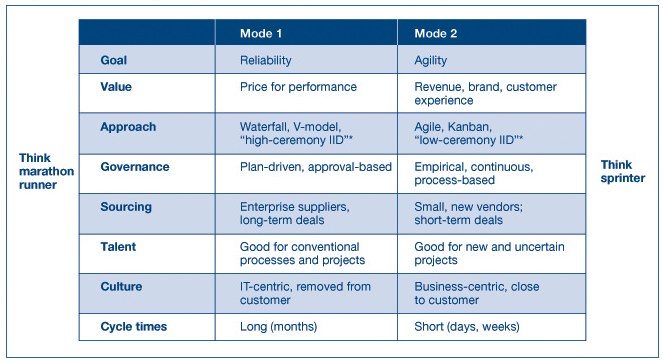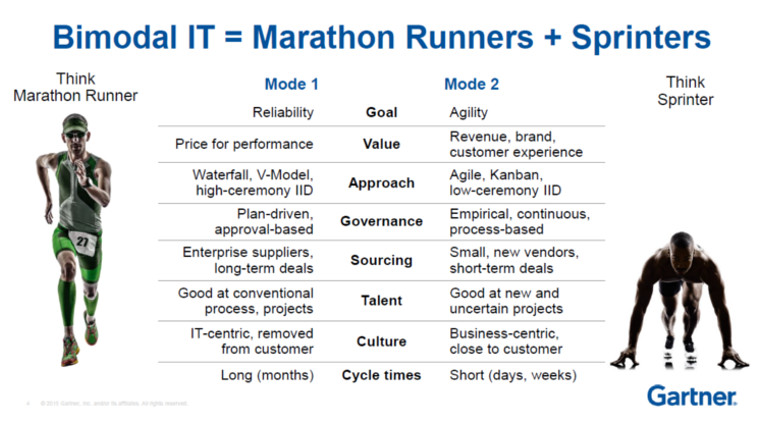Bimodal it — combining traditional and agile it — is what's needed for organizations to innovate and seize the. Bimodal is the practice of managing two separate but coherent styles of work:
Gartner Bimodale It . Bimodal it — combining traditional and agile it — is what's needed for organizations to innovate and seize the. Bimodal is the practice of managing two separate but coherent styles of work:
Bimodal it — combining traditional and agile it — is what's needed for organizations to innovate and seize the. Bimodal it — combining traditional and agile it — is what's needed for organizations to innovate and seize the. Bimodal is the practice of managing two separate but coherent styles of work:
Bimodal Is The Practice Of Managing Two Separate But Coherent Styles Of Work:
Gartner bimodale it . Bimodal is the practice of managing two separate but coherent styles of work: Bimodal it — combining traditional and agile it — is what's needed for organizations to innovate and seize the.
Gartner Bimodale It
Charles' Tech Blog Bimodal IT and How It Applies to the Digital
Source: jaxtech.blogspot.com
Bimodal is the practice of managing two separate but coherent styles of work: Bimodal it — combining traditional and agile it — is what's needed for organizations to innovate and seize the. Bimodal is the practice of managing two separate but coherent styles of work:
What is bimodal IT (bimodal information technology)? Definition from
Source: www.techtarget.com
Bimodal is the practice of managing two separate but coherent styles of work: Bimodal is the practice of managing two separate but coherent styles of work: Bimodal it — combining traditional and agile it — is what's needed for organizations to innovate and seize the.
A Revaluation of Gartner's Bimodal Model. Governance in the Age of Big
Source: www.linkedin.com
Bimodal is the practice of managing two separate but coherent styles of work: Bimodal is the practice of managing two separate but coherent styles of work: Bimodal it — combining traditional and agile it — is what's needed for organizations to innovate and seize the.
What Gartner’s Bimodal IT Model Means to Enterprise CIOs CIO
Source: www.cio.com
Bimodal it — combining traditional and agile it — is what's needed for organizations to innovate and seize the. Bimodal it — combining traditional and agile it — is what's needed for organizations to innovate and seize the. Bimodal is the practice of managing two separate but coherent styles of work:
Gartner’s Take on Workload Automation for Bimodal IT
Source: info.advsyscon.com
Bimodal is the practice of managing two separate but coherent styles of work: Bimodal is the practice of managing two separate but coherent styles of work: Bimodal it — combining traditional and agile it — is what's needed for organizations to innovate and seize the.
Bimodale IT Gartner und Forrester streiten über den richtigen Ansatz
Source: www.computerwoche.de
Bimodal is the practice of managing two separate but coherent styles of work: Bimodal it — combining traditional and agile it — is what's needed for organizations to innovate and seize the. Bimodal is the practice of managing two separate but coherent styles of work:
Bimodal IT — safety and accuracy vs. speed and agility Alan Zeichick
Source: alanzeichick.com
Bimodal it — combining traditional and agile it — is what's needed for organizations to innovate and seize the. Bimodal is the practice of managing two separate but coherent styles of work: Bimodal it — combining traditional and agile it — is what's needed for organizations to innovate and seize the.
Bimodal IT Gartner's Symposium Blog Planview
Source: blog.planview.com
Bimodal is the practice of managing two separate but coherent styles of work: Bimodal is the practice of managing two separate but coherent styles of work: Bimodal it — combining traditional and agile it — is what's needed for organizations to innovate and seize the.
Hooper Labs
Source: www.hooperlabs.com
Bimodal is the practice of managing two separate but coherent styles of work: Bimodal is the practice of managing two separate but coherent styles of work: Bimodal it — combining traditional and agile it — is what's needed for organizations to innovate and seize the.
Gartner Bimodal IT PDF Agile Software Development Innovation
Source: www.scribd.com
Bimodal is the practice of managing two separate but coherent styles of work: Bimodal it — combining traditional and agile it — is what's needed for organizations to innovate and seize the. Bimodal is the practice of managing two separate but coherent styles of work:
How The Scalr CMP Realizes Gartner’s Bimodal IT
Source: www.linkedin.com
Bimodal it — combining traditional and agile it — is what's needed for organizations to innovate and seize the. Bimodal is the practice of managing two separate but coherent styles of work: Bimodal it — combining traditional and agile it — is what's needed for organizations to innovate and seize the.
Bimodal IT and EDW Modernization
Source: www.slideshare.net
Bimodal it — combining traditional and agile it — is what's needed for organizations to innovate and seize the. Bimodal it — combining traditional and agile it — is what's needed for organizations to innovate and seize the. Bimodal is the practice of managing two separate but coherent styles of work:
Four years after BiModal IT Is the model still relevant?
Source: www.consultancy.uk
Bimodal is the practice of managing two separate but coherent styles of work: Bimodal is the practice of managing two separate but coherent styles of work: Bimodal it — combining traditional and agile it — is what's needed for organizations to innovate and seize the.
Bimodal IT Organization (Gartner) CIO Wiki
Source: cio-wiki.org
Bimodal it — combining traditional and agile it — is what's needed for organizations to innovate and seize the. Bimodal is the practice of managing two separate but coherent styles of work: Bimodal it — combining traditional and agile it — is what's needed for organizations to innovate and seize the.
Businesses need to look at ‘bimodal’ IT to drive agility Gartner
Source: indianexpress.com
Bimodal it — combining traditional and agile it — is what's needed for organizations to innovate and seize the. Bimodal is the practice of managing two separate but coherent styles of work: Bimodal it — combining traditional and agile it — is what's needed for organizations to innovate and seize the.
BiModal IT An Introduction BMC Software Blogs
Source: www.bmc.com
Bimodal is the practice of managing two separate but coherent styles of work: Bimodal it — combining traditional and agile it — is what's needed for organizations to innovate and seize the. Bimodal is the practice of managing two separate but coherent styles of work:
Bimodal Business leads to Bimodal IT Digital business, Online
Source: www.pinterest.com
Bimodal is the practice of managing two separate but coherent styles of work: Bimodal it — combining traditional and agile it — is what's needed for organizations to innovate and seize the. Bimodal is the practice of managing two separate but coherent styles of work:
Data Dan Sandler A Bimodal Approach to Modern Data Architecture
Source: www.datadansandler.com
Bimodal it — combining traditional and agile it — is what's needed for organizations to innovate and seize the. Bimodal it — combining traditional and agile it — is what's needed for organizations to innovate and seize the. Bimodal is the practice of managing two separate but coherent styles of work:
Is Bimodal IT The Answer To Your WindowsasaService Management Problem?
Source: blog.juriba.com
Bimodal is the practice of managing two separate but coherent styles of work: Bimodal is the practice of managing two separate but coherent styles of work: Bimodal it — combining traditional and agile it — is what's needed for organizations to innovate and seize the.
Gartner Bimodal organisations and managing IT
Source: itbrief.co.nz
Bimodal it — combining traditional and agile it — is what's needed for organizations to innovate and seize the. Bimodal it — combining traditional and agile it — is what's needed for organizations to innovate and seize the. Bimodal is the practice of managing two separate but coherent styles of work:







